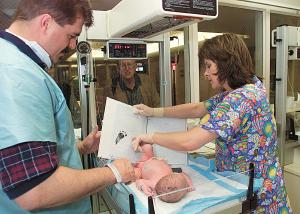|
Issue Date: July 4, 2003
Ethics at issue when public hospital is put into Catholic hands By SUZANNE BATCHELOR When a Catholic health care network took over a community hospital here in 1995, the resulting clash over whether the hospital could continue providing sterilization and contraceptive services to its poor patients led to intense negotiations between the Catholic system, the city and the community. The unusual solution: the creation of a “hospital-within-a-hospital,” run by the city and located on the building’s fifth floor, which will provide the services forbidden by ethical directives from the U.S. bishops. Austin’s solution may be unusual, but the dilemma is not. In the face of rising health care costs, many city- and county-based public hospitals across the United States have faced the decision to close or merge. Often, these local tax-supported hospitals have merged with a nearby hospital sustained by a large, national Catholic health care system. From 1990 through 2001, there were 171 such mergers of non-Catholic with Catholic hospitals, according to a 2002 report by Catholics for a Free Choice. While welcoming the survival of hospital services in their community, many non-Catholics express concerns that their own beliefs will not be respected in the Catholic facility if they request reproductive services that the U.S. bishops’ “Ethical and Religious Directives for Catholic Health Care Services” do not allow. Since 1884, Austin’s public hospital, Brackenridge, treated patients regardless of ability to pay. But in a state where one in five people has no health coverage, leaving public and charity hospitals to assume most of the resulting cost, the burden became too great for Brackenridge -- a crushing $38 million debt. Austin’s solution in 1995 was to lease Brackenridge and the adjacent Children’s Hospital to the Catholic Seton Healthcare Network. Seton Healthcare Network, which last year celebrated its own century of service in Austin, is part of Ascension Health, the nation’s largest not-for-profit health network, a merger of the Daughters of Charity National Health System based in St. Louis and the Sisters of St. Joseph Health System in Ann Arbor, Mich. But trouble of one sort -- financial -- was succeeded by trouble of another sort -- ethical. Brackenridge had provided sterilization and contraceptive services as an option for its 134,666 patients treated annually. Seton Healthcare could not provide those services. The initial solution reached by Seton and the city of Austin in 1995 was a “wall of separation” -- meaning that Seton staff didn’t provide proscribed services, city staff did. However, it was deemed inadequate in 2001 by the U.S. bishops, who were being prodded by the Vatican, which in turn was being fed alarmist material by local right-wing Catholics. The city began months of solution-seeking negotiations with Seton, plus a coalition of community groups that included Planned Parenthood, the Religious Coalition for Reproductive Choice, Consumers Union, the Texas Women’s Political Caucus, the League of Women Voters, the National Council of Jewish Women, the Gray Panthers, the National Organization for Women, the American Civil Liberties Union, and the Texas Abortion and Reproductive Rights Action League.
In 2002, Seton and the city reached a second agreement: The city would take back the fifth floor of Brackenridge Hospital and construct its own “hospital within a hospital” for services Seton would not provide. The unit is to open this month. A good solution? “Given the parameters our community gave us, I think it was a good one,” said Betty Dunkerley, who was the principal negotiator for the city of Austin.
However, Peggy Romberg, who headed the coalition of community groups in the negotiations, said the city didn’t fight hard enough for straightforward access to disputed services. “The people in the community are of diverse religions and beliefs, and to have one belief imposed on their health care is unfortunate and unfair,” she said.
In addition to Dunkerley and Romberg, other principal negotiators for the convoluted, hard-won decision were Patricia Hayes for Seton Healthcare Network, and Frances Kissling of national group Catholics for a Free Choice. According to Dunkerley, then assistant city manager, Brackenridge was in debt because it served the region but did not receive regional funding. The city picked up the tab. “That’s the issue,” said Dunkerley, who is now a city council member. The city looked to Seton, Austin’s only other nonprofit provider, for help. “Seton has obligations as a Catholic facility and we respect those,” Dunkerley said. “What we were trying to do was let Seton remain Catholic and let us do the things we need to do in dealing with a public hospital.” From June 2001 to February 2002, the toughest negotiations concerned emergency contraception: medication given within 72 hours of intercourse to prevent pregnancy. Seton agreed to provide it only to women who reported they’d been sexually assaulted and who tested negative for ovulation. Community advocates wanted Brackenridge to provide the medication to women who requested it, with or without a police report or test. Seton and the city finally agreed that women requesting emergency contraception without claiming sexual assault would be referred to a city clinic.
Romberg, CEO of the Women’s Health and Family Planning Association of Texas, called the emergency contraception agreement “a huge loss” because “close to 90 percent of sexual assaults go unreported.” As to the ovulation test, she said, “At the time when [a woman] most needs [emergency contraception], we’re not going to give it to her. “Nobody but the Catholic church calls it an abortifacient,” said Romberg, an Episcopalian. “When the Catholic church itself cannot convince its own parishioners to obey the church’s position on family planning and contraceptives and abortion, it is just outrageous that they would try and impose this on the general public.” The 2002 agreement calls for Seton to continue obstetrical and gynecological services on Brackenridge’s second floor while women requesting tubal ligation (defined as sterilization in the Catholic directives) or emergency contraception will go to the city’s fifth-floor hospital-within-a-hospital or a city clinic. Romberg argued that tubal ligation is the most widely used contraceptive, especially among low-income women, and is approved by the American College of Obstetricians and Gynecologists as safe and effective. Tubal ligation is the answer for many women who’ve completed their childbearing and is most appropriately done immediately following delivery, Romberg said, adding that these women should not be “segregated” in the hospital-within-a-hospital. She added that the fifth-floor facility will perform a limited number of tubal ligations despite the area’s growing population, potentially denying service to poor women. According to Romberg, “The city feared the hospital would go back to them; they considered it a financially losing proposition. In fact, Seton, in 1999 and 2000, made money managing that hospital. There’s no reason why the city couldn’t have.” Kissling of Catholics for a Free Choice said Brackenridge failed because Medicaid and Medicare reimbursements were too low for the city to sustain it, a government failure to meet its obligations. “If we were talking about a school district and the city said, ‘We don’t have enough money to operate our public school so we’re going to turn it over to the Catholic church,’ nobody would think that was an appropriate solution,” she said. “Why do we think it’s an appropriate solution for health care to turn it over to a religious institution?” Glenda Parks, executive director of Planned Parenthood of the Texas Capital Region, called for more financial disclosure from Seton: “We have their report that says they’ve paid for so much charity care. But how much money are they losing? I really don’t know the financial condition of Brackenridge and whether or not it makes or loses money, and to my knowledge no one knows,” said Parks, who was appointed a director for the hospital-within-a-hospital. “That is all considered proprietary information, which Seton does not disclose.” According to Hayes, who was temporarily Seton Healthcare Network CEO during negotiations, the network is able to run Brackenridge profitably because of philanthropy and its size. “It’s very hard for a stand-alone public hospital to take all the charity care,” said Hayes, now executive vice president and chief operating officer. “It’s easier to absorb that across a system.” In addition, as a not-for-profit, Seton returns gains to the operation. When the city first approached Seton about Brackenridge, Hays says, “Seton felt it was exactly in line with the reason we had been founded by the Daughters of Charity.” To comply with the 2001 directives, Seton worked closely with Austin Bishop Gregory Aymond and the National Bioethics Center, she said, just as Seton consulted Catholic ethicists for approval of the original lease. Hayes said that in the fiscal year ending June 30, 2001, Brackenridge “charity care,” narrowly defined as Seton’s cost for clinic care plus write-offs, was “around $37 million.” Add $14.5 million in unreimbursed Medicaid, $43 million unreimbursed Medicare and $9 million of what Seton calls “community benefit” -- immunization drives and health education -- and you have $103.5 million, Hayes said. “And that does not count bad debt.” Hayes said she found the negotiations “challenging,” particularly the criticisms from “spokespersons for sexual rights activists. I respect the fact that they were speaking their conscience and speaking it with energy,” she said, adding some activists expressed appreciation for Seton’s indigent care and need to follow its own conscience. Neither conservative Catholics nor the activists are likely happy with the solution, Hayes said, but Seton has been straightforward from the start about what it could and could not do at Brackenridge. “People talk about the directives as if it’s a book about sterilization. It’s a book about the ministry of Jesus in health care,” Hayes noted. “For me, the Seton Healthcare Network in Austin has taken that very seriously and has worked through some uncomfortable things to try to follow that mission.” The word from Rome is that the Congregation for the Doctrine of the Faith accepted the Austin arrangement as a way to deal with an existing and problematic situation, but not as a model for future arrangements. A report on the Catholic Health Association annual meeting June 8-11 is available on the NCR Web site, NCRonline.org Suzanne Batchelor is a freelance writer on national health care issues. National Catholic Reporter, July 4, 2003 |
 Clash and compromise
Clash and compromise


